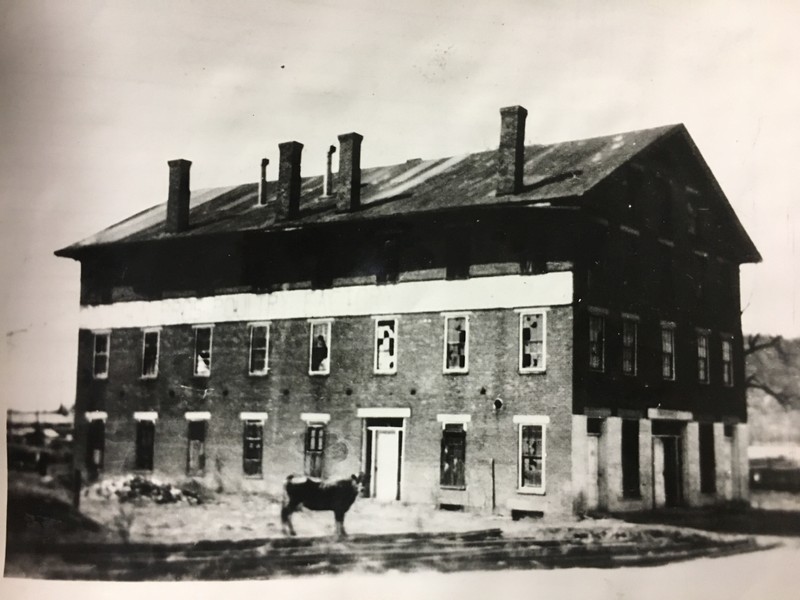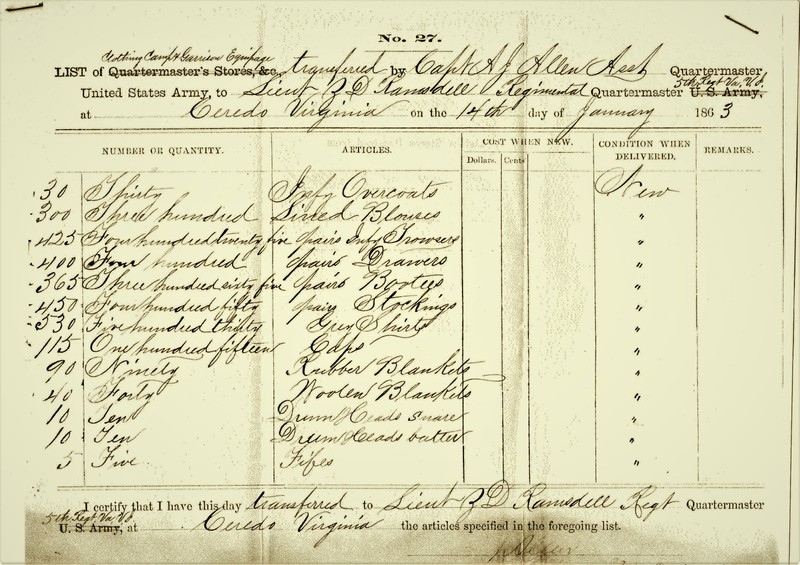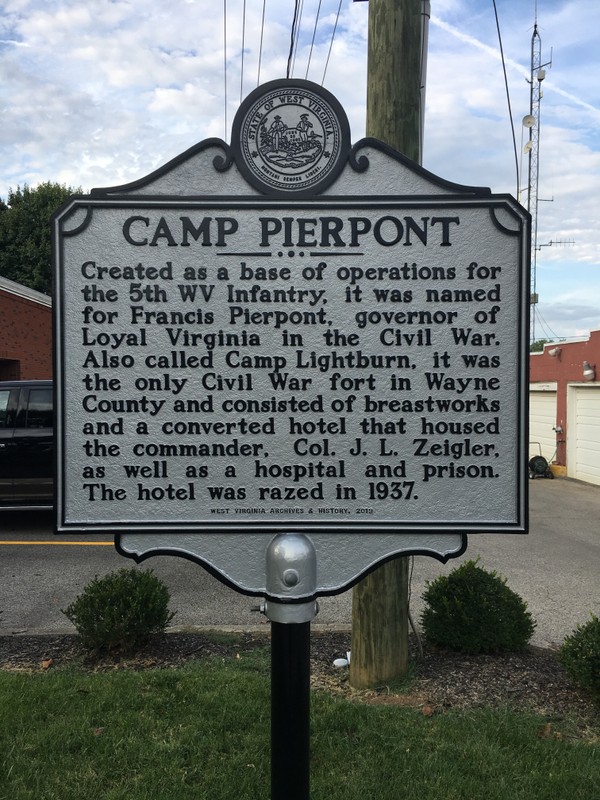Camp Pierpont Historical Marker
Introduction
Text-to-speech Audio
Images
Built in 1857 as a hotel near the 300 block East of B Street, this building was converted into Col. Zeigler's headquarters as well as a hospital and prison on the upper floors. The building was badly damaged in the 1937 flood and razed.

As quartermaster, Z. D. Ramsdell was in charge of acquiring supplies for the 5th West Virginia. In this document Ramsdell is submitting an order for, among other things, forty woolen blankets and five fifes.

This historical marker commemorating Camp Pierpont was placed beside the municipal building in 2019.

Backstory and Context
Text-to-speech Audio
The outbreak of the Civil War in 1861 left Wayne County heavily divided much like the nation itself. The town of Wayne and much of the county was pro-secession, while Ceredo and northern parts of the county were more pro-Union. This was due primarily to the influx of New England settlers moving to the area in the 1850s as part of Eli Thayer’s plan to establish an abolitionist settlement in a slave state. Confederate sympathizers formed the Fairview Rifle Guard, the Wayne County Militia (also known as the 167th Regiment of the Virginia Militia), and Companies H and E of the 16th Virginia Calvary Regiment. Union supporters meanwhile formed the 5th Virginia Volunteer Infantry Regiment (later changed to West Virginia after statehood in 1863).
Though organized earlier in the summer, the 5th West Virginia was officially mustered into federal service on October 18, 1861. The majority of men who joined the regiment were actually from southern Ohio and eastern Kentucky; only Companies B and F were primarily made up of Wayne County residents. The regiment was originally under the command of Colonel John L. Zeigler. Other notable locals included Zopher D. Ramsdell, who served as Quartermaster, and his son-in-law Dr. John T. Wharton. The 5th West Virginia was stationed in Ceredo, and a small fort was soon built. It was named Camp Pierpont after Francis Pierpont, governor of the Restored Government of Virginia. The Camp was located where the city hall, police department, and fire department stand today. Breastworks were constructed from Main Street to 1st Street East. Col. Zeigler set up his headquarters in the Thayer Hotel, (also known as Ceredo House and Crescent Hall) which stood behind the present-day city hall and faced 1st Street East. The 5th West Virginia was moved to Parkersburg in December 1861. They were replaced at Camp Pierpont by the 4th West Virginia US Infantry, which was stationed there until April 1862; during this time the garrison was known as Camp Lightburn, in honor of the 4th’s Colonel Joseph Lightburn. The name Camp Pierpont was used again when the 5th West Virginia returned.
The 5th West Virginia initially participated in several skirmishes throughout Wayne County and the surrounding area. Their first major engagement was the Battle of Wayne Courthouse in August 1861. Union troops effortlessly marched into the town of Wayne, occupied the town for four days, and seized the county records before leaving; ten rebels were killed and one Union soldier went missing. On November 11, 1861 the 5th West Virginia arrived at the Battle of Guyandotte, only to find that it had already ended with a Confederate victory and one hundred Union soldiers captured. In retaliation the regiment burned much of the town to the ground. The torching, as well as later allegations accusing him of intoxication, derelict of duty, and abuse of subordinates, led to Col. Zeigler being discharged in 1863. When not in the Ceredo area, the 5th West Virginia fought in a number of battles in Virginia. These included the Battle of McDowell, the Battle of Cross Keys, the Battle of Cedar Mountain, the Second Battle of Bull Run, and the Third Battle of Winchester. On November 9, 1864 the 5th West Virginia was consolidated into the 1st West Virginia Veteran Infantry and ceased to exist. The 5th West Virginia suffered 151 fatalities in total.
The town of Ceredo was mostly destroyed despite the presence of Camp Pierpont. During the 5th West Virginia’s stay, Col. Zeigler confiscated numerous houses and buildings to use as hospitals, prisons, stables, and barracks, damaging or destroying them in the process. From March 1864 to April 1865 all Union troops, including the 5th West Virginia, had been dispatched to fight elsewhere, leaving Wayne County at the mercy of the rebels. In September 1864 Rebel Bill Smith pillaged Ceredo and supposedly captured all remaining able-bodied males in town. In February 1865 rebel guerillas attacked Ceredo again, occupied the main houses, and burned the home of a Union spy. By the end of the war Ceredo was in ruins; its infrastructure and factories destroyed, and its population decimated. Many residents left the town, including nearly all of the New England transplants. In 1867 two companies of the U.S. army were stationed in Ceredo to maintain order, due to lingering rebel activities occurring in the county. Exactly when Camp Pierpont shut down is unclear, but nothing of the fort remains today. Some documents and other minor relics from Camp Pierpont can be found in the Ceredo Museum.
Cite This Entry
Admin, Clio, Steven C. Straley on behalf of Appalachian Studies Association , and Steven Cody Straley. "Camp Pierpont Historical Marker." Clio: Your Guide to History. November 21, 2019. Accessed April 15, 2025. https://theclio.com/tour/164/10
Sources
- Dickinson, Jack L. Wayne County, West Virginia, in the Civil War. Salem, MA: Higginson Book Company, 2003.
- Napier, Mose A. Ceredo: It's Founders & Families. Ceredo, WV: The Phoenix Systems, Ltd., 1989.
- Perry, Matthew A. Protectors of the Ohio Valley: The Fifth West Virginia Volunteer Infantry. 2016.
- Stewart, Fay Jean. "Ceredo-Kenova: West Virginia's Gateway to the West." Master's thesis, West Virginia University, 1942.
- Thompson, Robert Michael. Pioneers, Rebels, and Wolves: A History of Wayne County. 2010.
- Thompson, Robert Michael, and Samantha Lea Thompson. Aging Wonders: The Birth of Ceredo-Kenova. 2011.
- Wallen, Lucy. "Ceredo's Volunteer Unit Was In Thick Of Civil War Fighting." The Herald-Dispatch (Huntington, West Virginia), September 07, 1970.

